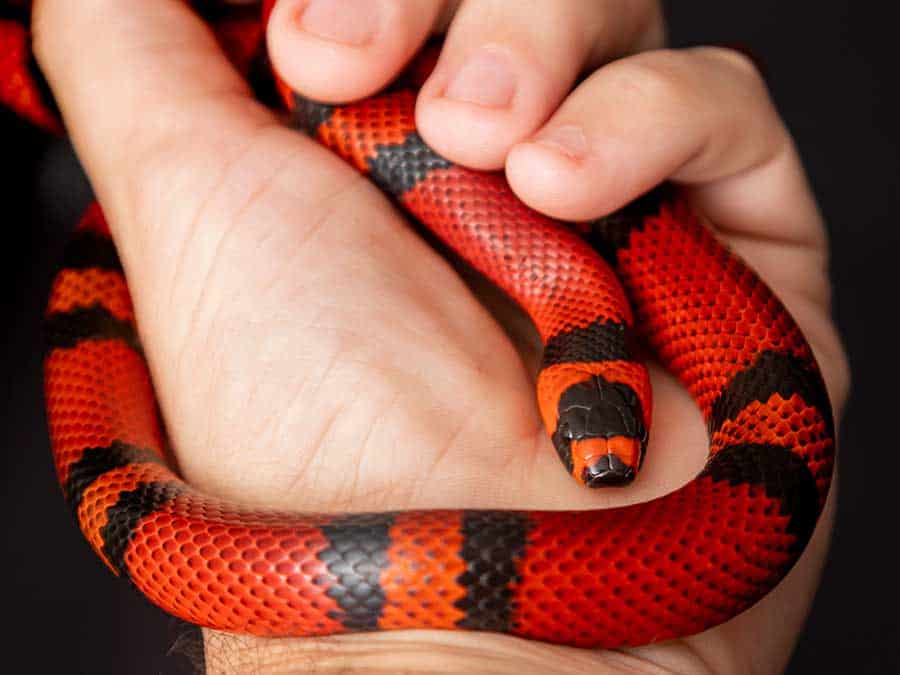Whether you’re a new reptile owner or an experienced keeper, it can sometimes be tricky to tell male vs female snakes apart.
Not many people can tell the difference because for many species of snake, sexual dimorphism isn’t really a thing. This means there are not many visible differences between males and females of the same species.
You will only be able to see the differences between male and female snakes once you handle them and examine their bodies.
Male and female snakes share most of the same behaviors and personalities, so you don’t need to worry about that if you’re wondering which sex of snake to get. However, if you are planning on breeding your snakes, then you definitely need to know which are males and which are females to successfully breed them!
Read on to find out how to tell if a snake is male or female.
4 Differences Between Male vs Female Snakes
The main differences between male vs female snakes are:
- Size: Male snakes are larger in some species, whereas females are larger in others.
- Sex organs: Male snakes have hemipenes (penises), whereas female snakes do not have hemipenes.
- Spurs: Male snakes have more pronounced anal spurs, whereas most females have very small anal spurs.
- Tails: Male snakes have short and blunt tails, whereas female snakes often have longer and pointier tails.
How to Tell if a Snake is Male or Female
It is fairly difficult for an untrained eye to determine the difference between the two sexes in snakes.
That is because most snakes are not sexually dimorphic (i.e. look different based on their sex). Most male and female snakes of the same species share the same markings and coloration.
However using our 4 point checklist to differences between male and female snakes can set you on the right path.
Appearance and Size
There is no hard and fast rule that males are bigger than females or vice versa. In some species, the male snakes will be much larger than the females, and in other species, the female can be almost triple the size of the male!
For example female ball pythons are generally bigger than male pythons and full grown females can grow up to 60 feet (and require a 60 gallon tank!)
Therefore, unless you have a growth chart on hand or a male and female of the same age right next to each other, it will be tricky to tell the sex of a snake based on its size.
Male Snakes Size
Male snakes are larger than female snakes in only 14% of snake species!
In these species, you’ll often find that the males will fight over resources, territory, mates, and more. Therefore, as a rule of thumb, if your species of snake has larger males than females, do not house the males together.
Female Snakes
Female snakes are larger than male snakes in approximately 66% of all snake species. For these species, a female snake will need a larger enclosure than a male snake.
It’s important to research the type of snake you want and see if the male or female is smaller because this will affect what size enclosure you need.
Reproductive Organs
Snakes have two penises! This is because they have tails, and males need access to the female’s cloaca (where reproduction takes place) no matter which side of her tail he ends up on.

Male snakes have hemipenes tucked away inside of their cloaca. These hemipenes only come out when the snake is ready to mate. Due to their hemipenes, male snakes will often have a slightly thicker tail around their cloaca.
Females can be identified by the lack of hemipenes or through an ultrasound of her follicles. You can take her to the vet to get an ultrasound done.
Probing
You can determine whether your snake has hemipenes or not by probing their cloacas with a snake probe kit. This is a very delicate procedure that should not be done by beginners. If done incorrectly, you can damage your snake permanently. A reptile veterinarian or an experienced reptile breeder will be able to help you with this if you are inexperienced.
Female snakes do not have hemipenes. If you probe their cloaca, there will be a space inside instead of the hemipenes present in males.
Popping
Another method of determining if a snake has hemipenes is by ‘popping’ them. You place your thumb on the belly side of the cloaca and apply gentle pressure, then run your thumb towards the cloaca.
A young male’s hemipenes will generally pop out, whereas adult males who have reached sexual maturity can hold their hemipenes inside. This method is a bit safer, but it still shouldn’t be attempted by beginner reptile owners. It also is not the most reliable method of determining a snake’s sex.
Anal Spurs
Anal spurs are bony protrusions on either side of the cloaca. The cloaca is based at the end of the body near the tail base. These spurs are remnants of hind limbs when snakes used to crawl like other lizards in prehistoric times! They are very pronounced on old-world snakes such as pythons and boas but not on more evolved snakes.
Most male snakes will have larger anal spurs than females. Males will use these spurs to grip onto a female during mating.
Female snakes may also have anal spurs, though they aren’t always present. They are generally smaller than a male’s anal spurs, though.
Anal spurs are not a hard and fast rule when it comes to determining sex. They are unique to the species of the snake itself, so in some cases a female may have very large anal spurs while a male may have very small ones.
Therefore, you should not rely only on the presence of anal spurs to determine the sex of your snake.
Tail Thickness
Did you know that snakes have separate bodies and tails? Well they do and there are actually some noticeably differences between male vs female snake tails.
The body of a snake contains all of the internal organs and important parts of the nervous system. At the end of a snake’s body, there is the cloaca. The cloaca is the multipurpose entry and exit hole for reptiles.
This simply means snakes poop, pee, lay eggs, give birth, and mate all through their cloacas. From their cloacas onward are their tails! A snake’s tail is mainly made up of muscle and fat.
A male snake’s tail will be much broader or fatter right after the cloaca. Then, from the cloaca, it slims down a little before ending in a blunt, rounded tip.
A female snake’s tail continues from her cloaca and slowly starts tapering off and thinning down to a delicate point at the end. It isn’t as rounded on the end as a male snake’s tail.

FAQs About Male and Female Snakes
Can I house two male snakes together?
Most species of male snakes commonly kept as pets are not typically aggressive and can be housed in pairs or groups.
However, their enclosure needs to be increased by 10 gallons for each snake. In addition to the size increase, there needs to be the same number of hides as there are snakes as well as a larger
Although they will happily live together, they must not be fed together. While they may not be competing for food, their prey drives are high, and they may bite one of their housemates by accident.
Some species of snakes cannot have males housed together as they are territorial and will be aggressive.All of these rules apply to female snakes, too! Be sure to research your specific breed of snake to determine if they can be cohabitated with other members of their species.
Can I house a male and female snake together?
When you house a male and female snake in the same enclosure, you run the risk of accidental babies! If you are not planning on breeding your snakes, do not house males and females together.
Is there a difference in husbandry for male and female snakes?
The enclosure setup, handling routines, and general care requirements of male and female snakes are identical. The only real difference in care between the two sexes is the need for additional
When females are producing eggs or baby snakes, they need additional calcium to stay healthy; otherwise, they can suffer from metabolic bone disease.
Slithering Off…
The main differences between male and female snakes are their size, the presence of hemipenes, the size of anal spurs, and the shape and size of the tail.
One sex is not better or easier to care for than the other! While it helps to know the difference between the two sexes for breeding purposes, male and female snakes’ temperaments and care needs are virtually the same.
There are no real personality or temperament differences between male vs female snakes. You will only need to know the difference between the sexes if you are intending to house them together or planning on breeding them.
In that case, you will need to know which is a male and which is a female snake to determine their sleeping arrangements and who gets a




